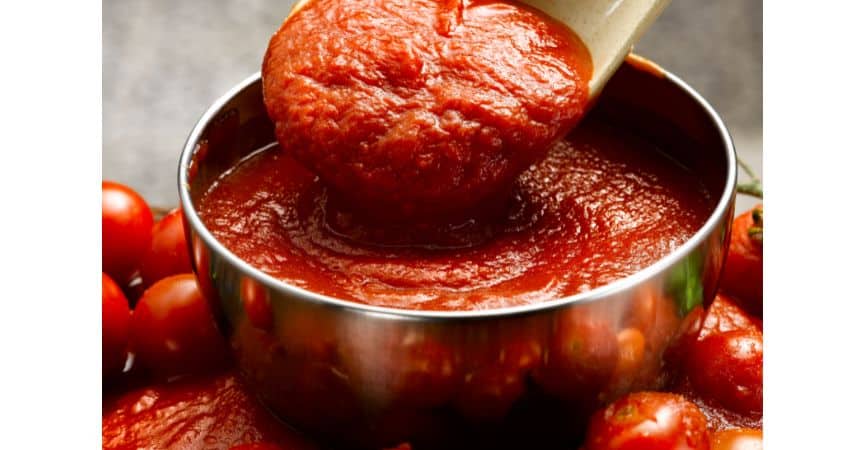A Guide To Freezing Tomatoes
Tomatoes turn pretty fast, it would be wonderful to preserve them by freezing. They are soft and mushy making many people wonder, can you freeze tomatoes?
Tomatoes can be frozen and kept in the freezer for up to six months. Tomatoes can be frozen uncooked or blanched before freezing. Frozen tomatoes are best for stews, soups or sauces once thawed because they don’t retain their original texture.
As a Certified Health Coach I get asked about freezing food like tomatoes. Therefore, I’ve researched and studied about this topic. In this article, I will detail how to preserve tomatoes, step by step, for both techniques. In addition, I’ll inform you if freezing them affects their nutrient contents.
How To Freeze Tomatoes

Freezing tomatoes is a simple, quick job requiring very little preparation. You can use two techniques for freezing, therefore let’s take a look at each one in greater detail1. I’ve personally performed both of them.
How To Freeze Tomatoes Without Blanching
Direct freezing without blanching2 is the more preferred method if you are planning to use the frozen tomatoes within the next 4 to 6 weeks.
It requires less preparation, and using the tomatoes within a month after freezing will help get a richer flavor out of them.
To freeze tomatoes without blanching follow these steps:
- Cut off the branches of the tomatoes as well as the rough, white stem scars lying below the stem.
- If dicing the tomatoes, cut them into the desired size.
- If planning to freeze many tomatoes, dicing them will help create more storage space.
- Place the tomatoes (diced or whole) on a cookie sheet and place them in the freezer for 4-6 hours.
- Once frozen, transfer them to airtight containers or zip lock bags squeezing out the excess air.
- Place them in the freezer for up to six months.
It’s important to mention, once more, direct freezing works best if you are planning to use the tomatoes within a month or two. Beyond this timeline, they will start to lose their tangy flavor.
How To Blanch And Freeze Tomatoes
Blanching is a slightly more complex process and one that preserves a tomato’s flavor and nutrients for a more extended period of time. Blanching involves steaming or boiling before freezing.
Therefore, if you’re planning to use tomatoes for cooking over the next six months, blanching would be more effective than direct freezing.
The best way to blanch and freeze tomatoes:
- Remove the stems and cut out the stem scars lying below the surface.
- Flip each tomato over and make two small slits at the bottom forming an ‘X.’
- Fill a large bowl with ice and water.
- Place the tomatoes into boiling water for 2 minutes or until the skin splits.
- Transfer the tomatoes to the bowl of ice water.
- Once the tomatoes have cooled down and can be handled, peel off the skin starting at the X.
- Place the peeled tomatoes into an airtight container and remove as much excess air as possible.
- Write the date on the container and place into the freezer for up to six months.
How To Freeze Tomatoes For Spaghetti Sauce

Freezing tomatoes for making sauce in the future is similar to the blanching method above with one extra step after peeling.
How to freeze tomatoes for tomato sauce:
- Remove the stems and cut out the stem scars lying below the surface.
- Flip each tomato over and make two small slits at the bottom forming an ‘X.’
- Fill a large bowl with ice and water.
- Place the tomatoes into boiling water for 2 minutes or until the skin splits.
- Transfer the tomatoes to the bowl of ice water.
- Once the tomatoes have cooled down and can be handled, peel off the skin starting at the X.
- Crush the peeled tomatoes by hand.
- Place the crushed tomatoes into an airtight container and remove as much excess air as possible.
- Leave at least an inch or two of space between the surface of the tomatoes and the container’s lid as the tomatoes tend to expand while freezing.
- Write the date on the container and place into the freezer for up to six months.
How To Freeze Cherry Tomatoes
- Remove the stems and cut out any stem scars lying below the surface.
- Place the cherry tomatoes on a cookie sheet spaced apart and not touching each other.
- Place the cookie sheet in the freezer for one hour or until they are frozen.
- Once frozen, transfer them to airtight containers or zip lock bags squeezing out the excess air.
- Place them in the freezer for up to six months.
Freezing cherry tomatoes is much quicker than regular tomatoes because they freeze quicker. The best way to defrost them is removing them from the freezer and placing them in the refrigerator until thawed.
If time is of the essence, place them in a bowl on the counter until thawed. Defrosted cherry tomatoes lose their shape and crispness. Therefore, they are not as good for salads but are great for soups, stews or other similar recipes.
How To Freeze Tomato Juice
If you’ve already prepared tomato juice3 and want to freeze the remainder for future use, follow these steps on how to freeze tomato juice:
- Pour prepared tomato juice into an airtight freezer plastic container.
- Leave empty space at the top of the container. 1/2 inch for one pint, 1 inch for one quart.
- Seal the container and date it.
- Place into the freezer for up to six months.
Disclaimer: Some links in this article are affiliate links which means I may earn a small commission at no extra cost to you. As an Amazon associate I earn from qualifying purchases.
The Best Container For Freezing Tomatoes
The best containers for freezing tomatoes are plastic freezer containers or plastic freezer bags. Do not freeze tomatoes in glass jars because the tomatoes may expand and crack the glass. Check current prices on Amazon for Plastic Food Storage Containers.
Always leave some headspace, room at the top of the plastic container. Leave 1/2 inch for one pint and 1 inch for one quart4.
When using a plastic freezer bag, the best way to remove the excess air from the bag is using a vacuum sealer. If you don’t have one, squeeze as much air out as possible and close the top almost all the way. Insert a straw and suck out the remaining air and then fully seal the top.
Vacuum sealers one of those items making you wonder how you did without it prior to owning one. Check out affordable ones on Amazon here, Vacuum Sealers.
Does Freezing Tomatoes Ruin Them?
Freezing tomatoes does not ruin them as they do not retain their regular firmness, shape, or texture after being frozen for a few weeks. Additionally, the flavor and aroma are not as rich or exuberant as the taste and fragrance of fresh produce.
As such, frozen tomatoes can only be used in a handful of preparations, like recipes using cooked tomatoes. Otherwise, they might make a gooey salad or a sloppy sandwich, as freezing results in the loss of firmness.
You can still use them in a variety of ‘saucy’ dishes. Soups, stews, broths and chilies are the perfect recipes to try out, as frozen tomatoes still retain the thickness and saucy flavor. Few things can compare to the comfort of having a warm tomato soup or stew during the cold winter months.
They are also great for making pasta sauce as they contain much more of the natural flavor than canned tomatoes or readymade sauces.
Freezing Tomatoes and Nutrients
Nutritional value after freezing is often debated. One of those reasons is how the tomatoes are frozen which alters the results differently.
Freezing tomatoes reduces some nutrients when frozen for more than a year. If the tomatoes are blanched prior to freezing, the blanching results in the loss of water-soluble and oxygen-labile nutrients like vitamin C and B vitamins.
Studies5 comparing the antioxidant activity and nutrient density between frozen produce and fresh produce found only a tiny difference between the two6.
On the other hand, when vegetables are blanched, the nutrient loss is greater. The loss varies from 10-80% depending on the vegetable and how long it’s blanched for. The average length of nutrient loss from freezing is approximately 50%.
In fact, while frozen tomatoes may be less rich in nutrients as fresh ones, they retain nutrients far longer than tomatoes stored out in the open. In addition, without freezing or some other preservation method, you can barely store tomatoes for longer than a few days.
Of course, you won’t find a method of preservation retaining the density of nutrients present in freshly harvested tomatoes. A slight drop in nutritional value and antioxidant activity is a small price to pay to be able to use tomatoes throughout the year.
Check out the blanching pot used in this blanching video. If interested, you can purchase them on Amazon here, Blanching Pots.
If you have any questions to ask me about this article don’t hesitate to comment below or email us. You can find an email on our contact page.
Read Next – More Food Storage Articles!
This Is The Best way To Store Kimchi
Can Oatmeal Go bad? (Find Out Here)
- University of California: Tomatoes: Safe Methods to Store, Preserve, and Enjoy [↩]
- University of Nebraska-Lincoln: How to Freeze Tomatoes [↩]
- National center for Home Food Preservation: Freezing Tomatoes [↩]
- University Of Minnesota Extension: Three ways to freeze fresh raw tomatoes [↩]
- National Center for Biotechnology Information: Effects of hot air and freeze drying methods on antioxidant activity, colour and some nutritional characteristics of strawberry tree (Arbutus unedo L) fruit [↩]
- Wiley Online Library: Nutritional comparison of fresh, frozen and canned fruits and vegetables. Part 1. Vitamins C and B and phenolic compounds [↩]
